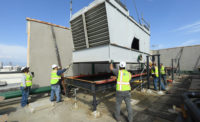In the next 30 years, California has a 99.7% chance of a magnitude-6.7 or higher earthquake, and the Pacific Northwest has a 10% chance of a magnitude-8 to -9 mega-thrust Cascadia subduction-zone quake, says the National Aeronautics and Space Administration.
Just a few seconds of warning could save thousands of lives and billions of dollars in damages, but seismically vulnerable areas in California, Washington and Oregon remain without adequate alert systems, says John Parrish, California state geologist. “The technology exists, but it’s not quite ready for prime time, mostly because of funding,” he notes.
ShakeAlert, an earthquake early warning system (EEW), has been in development for 10 years. Not ready for a public rollout, it recently entered beta-testing, say the geologists and engineers who built it.
Scientific advances come with a price. ShakeAlert has evolved with modest funding, mostly from the United States Geological Survey (USGS), but California can’t tap its general fund to support the program because of legislative rules. Inaction from state officials has further complicated the work for engineers.
California in 2013 passed legislation that directed the state’s Office of Emergency Services “to develop a comprehensive statewide earthquake early warning system.” A Jan. 1, 2016, deadline for OES to find $80 million to fund ShakeAlert passed with only a fraction secured.
Similar complications have slowed EEW efforts in Oregon and Washington, and critics of the ShakeAlert time line say the lack of urgency could prove to be dangerous if the system isn’t available to the public before the next “big one.”
Public officials feel pressure only to upgrade seismic networks every 10 years—“usually after an earthquake,” says Jennifer Strauss, chairman for education and training at the Berkeley Seismologic Laboratory. Nevertheless, the project has been gaining momentum over the past 12 months. The White House held its first-ever “Earthquake Resiliency Summit” in February, and USGS last summer awarded approximately $4 million to four universities—the University of Washington, the University of Oregon, the California Institute of Technology and the University of California, Berkeley—to launch beta testing.
More than 70 organizations, including Bay Area Rapid Transit, Boeing, Intel and the city of Los Angeles, are test users.
A fairly complex system, ShakeAlert places seismic sensors at strategic locations to send signals generated by the first earthquake “waves” to mainframe computers, Strauss says.
The computers determine the strength and distance of the waves and send information about the intensity and duration of expected tremors to electronic devices, such as televisions, computers and smartphones. “Our algorithms can now quickly assess P-waves and provide details about the impending shaking, sometimes before the S-wave even reaches the surface,” Strauss says.
Supercomputers at Berkeley and Caltech can alert machinery, open doors to fire stations, signal airports to stop planes from landing, shut down pipelines, stop elevators and secure heavy-load cranes, Parrish adds.
Even 30 seconds of warning would give operators the chance to lock down machinery and move to safer ground, Parrish says, noting, “We have the instruments, and we’ve reached a state of satisfaction that we can do this well. But we need the proper funding to put it out.”
Alerting the populace is especially critical in California, where much of the population resides directly on fault lines and would have the least amount of time to respond to an alert. Without proper education, however, an alert could generate more panic and confusion than preventative action. “It could have the opposite effect,” Parrish observes.
Berkeley says ShakeAlert needs an annual budget of $16.2 million for regular operations and maintenance and a one-time capital investment in field infrastructure of approximately $30 million.





Post a comment to this article
Report Abusive Comment